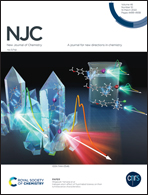Synthesis and characterization of novel copper(ii) complexes as potential drug candidates against SARS-CoV-2 main protease†
Abstract
Two novel copper(II) Schiff base complexes, [Cu(L1)2] (1) and [Cu(L2)(CH3OH)(Cl)] (2) of [(Z)-(5-chloro-2-((3,5-dichloro-2-hydroxybenzylidene)amino)phenyl)(phenyl)methanone (L1H) and (Z)-(2((5-bromo-2-hydroxybenzylidene)amino-5-chlorophenyl)(phenyl)methanone)(L2H)], have been designed, synthesized and characterized. The crystal structures of both complexes were solved by single-crystal X-ray analysis, which revealed that complex (1) has a square planar geometry with a tetrahedral distortion, while complex (2) exhibits a square pyramid structure with distortion geometry. DFT calculations were performed on the complexes to investigate the structure–property relationship. Hirshfeld surface analyses have also been explored in the crystal structure of complexes. Additionally, their potential applications against the SARS-COV-2 virus were explored by in silico docking studies. We found stable docked structures wherein docked copper(II) complexes (1) and (2) could readily bind to the viral proteins (PDB ID: 7BUY and 7BRP) of the SARS-CoV-2 main protease (Mpro) active-site region. The molecular docking calculations of complex (1) into the main protease of SARS-CoV-2 (PDB ID: 7BUY) revealed a binding energy of −9.8 kcal mol−1 with an inhibition constant of 4.235 μM, whereas that of complex (2) with SARS-CoV-2 resulted in a binding energy of −9.3 kcal mol−1 and an inhibition constant of 3.152 μM. Similarly, copper complexes (1) and (2) with SARS-CoV-2 main protease (PDB ID: 7BRP) exhibited binding energy and inhibition constant of −8.7 kcal mol−1 and 2.585 μM; −8.2 kcal mol−1 and 2.359 μM, respectively, at the inhibition binding site of the receptor protein. Overall, our in silico studies explored the potential role of copper complexes, which would offer new drug candidates against SARS-CoV-2.



 Please wait while we load your content...
Please wait while we load your content...